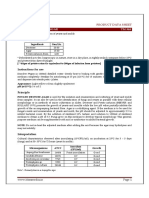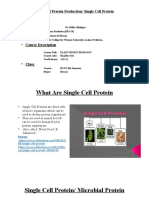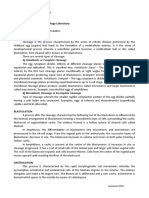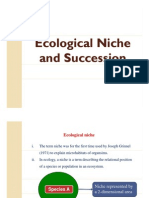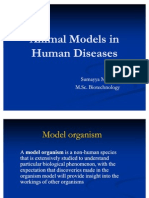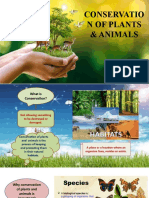Marine Ecosystem
Marine Ecosystem
Uploaded by
Edvie Mae BaralCopyright:
Available Formats
Marine Ecosystem
Marine Ecosystem
Uploaded by
Edvie Mae BaralCopyright
Available Formats
Share this document
Did you find this document useful?
Is this content inappropriate?
Copyright:
Available Formats
Marine Ecosystem
Marine Ecosystem
Uploaded by
Edvie Mae BaralCopyright:
Available Formats
Marine Ecosystems
Whats life like underwater?
Whats life like underwater?
Photic Zones Aphotic Zones Benthic Zones
Whats life like underwater?
Warmer near the equator and colder near the poles Deeper : Colder Current can carry water significantly warmer or cooler than would be typical
Whats life like underwater?
Oxygen, nitrogen, Potassium and Phosphorus
Loose deposits of sand, gravel or shells 2/3 of the worlds ice-free coastlines Serve as a buffer zone Dynamic Environment Harsh and unstable environment (some species hare adapted well to this environment)
High tide brings with it nutrients and food Water is available regularly with the tides (varies) Some small animals burrow into the sand and feed on material deposited by the waves.
Changing tides, pounding waves, and competition for food and space (physical and biological factors) As the tide goes out, water loss becomes a problem for residents of the intertidal zone As the tide rises, organisms must deal with the physical pounding of waves
Supply of water is intermittent The wave action High exposure to the sun Salinity is much higher in the intertidal zone
Along coastlines, in cool waters It contains large communities of brown algae. The keystone species are the algae, purple sea urchins, and sea otters.
Lie at the edge of land and sea, on waveprotected coasts Low-lying, salt-tolerant vegetation Communities of emergent herbs, grasses, or low shrubs, rooted in soils Highly productive environments
Feeding and breeding grounds for bird species Plant material from salt marshes is broken down by microorganisms Filter and store pollutants Natural barrier
Hard corals build by secreting calcium carbonate skeletons Boring organisms break down the coral skeletons Stabilizing the reef structure: Cementation
The Pelagic Zone This community contains 83% of the oceans total biomass in the uppermost 200 meters.
The Benthic Zone This marine community is very cold. It has a high level of salinity, density, and pressure. Some organisms thrive in this environment especially the brittle star.
Super-heated water, mineral rich Bacteria are the primary producers and make food through chemosynthesis Deep sea fish are at the top of the food chain in this environment
(A) Sea anemones and Stalked Barnacles (B) Sea Anemones and Snails (C) Sea Anemones and Yeti Crabs (D) Snails (E) Stalked Barnacles and Starfish (F) Ian Octopus.
Walrus Humans Ice Algae Fish Phytoplankton
Seal
Polar Bears
Jellyfish
Zooplankton Bowhead Whale Detritus
Sea Stars and Sea Urchins
Petrels Orcas Fur Seals
Penguins
Jellyfish Phytoplankton Salps
Crabeater Seals
Ctenophores
Leopard Seals Copepads Fish Squids Baleen Whales
Krill
Petrels Orcas Fur Seals
Penguins
Crabeater Seals Pteropods Salps
Juvenile Krill Ctenophores
Leopard Seals Amphipods Fish Squids Copepods Baleen Whales
Krill
Marine Ecosystems
Edvie Mae V. Baral Elena M. Mercado
You might also like
- Shelby Bottoms Lab ActivityDocument2 pagesShelby Bottoms Lab Activityapi-662714752No ratings yet
- Kruskal-Wallis Tests (Simulation)Document15 pagesKruskal-Wallis Tests (Simulation)scjofyWFawlroa2r06YFVabfbajNo ratings yet
- Freshwater Ecosystems NotesDocument47 pagesFreshwater Ecosystems Notescallme kgNo ratings yet
- Chapter 7 Power Point NotesDocument36 pagesChapter 7 Power Point Notesapi-285078865No ratings yet
- Full Specification and Technical Data Sheet of Potato Dextrose AgarDocument2 pagesFull Specification and Technical Data Sheet of Potato Dextrose AgarKunal VermaNo ratings yet
- Physical and Chemical Factors of Lake EcosystemDocument31 pagesPhysical and Chemical Factors of Lake EcosystemEllaine Larren RazonNo ratings yet
- Potato Dextrose Agar (7149)Document2 pagesPotato Dextrose Agar (7149)Nelson MubaiNo ratings yet
- RNA Plant and Animal Virus Replication PDFDocument9 pagesRNA Plant and Animal Virus Replication PDFmanoj_rkl_07No ratings yet
- ScientificDocument1 pageScientificapi-190382013No ratings yet
- Microbial Systematics and Taxonomy: Relevance For A Microbial Commons (Moore 2010)Document9 pagesMicrobial Systematics and Taxonomy: Relevance For A Microbial Commons (Moore 2010)Jayson GarciaNo ratings yet
- Units: 3. U.S. Units of Measurement 4. Tables of EquivalentsDocument8 pagesUnits: 3. U.S. Units of Measurement 4. Tables of EquivalentsAndré OliveiraNo ratings yet
- Lecture 7 Probiotic Bacteria For AquacultureDocument36 pagesLecture 7 Probiotic Bacteria For AquacultureAnnisa IchaNo ratings yet
- Systematic Approaches To Phylogeny)Document26 pagesSystematic Approaches To Phylogeny)Mhi Ismail100% (1)
- Quadrat SamplingDocument6 pagesQuadrat SamplingSabreena NordinNo ratings yet
- Lesson 2 - Ecological Dynamics and ConceptsDocument68 pagesLesson 2 - Ecological Dynamics and ConceptsIgnacio Joshua H.No ratings yet
- Agricultural MicrobiologyDocument9 pagesAgricultural Microbiologyfefaw934580% (1)
- Green Algae - ChlorophytaDocument16 pagesGreen Algae - ChlorophytaAbhishek Isaac MathewNo ratings yet
- Aerobic Anaerobic Fermentation1Document16 pagesAerobic Anaerobic Fermentation1Ken AguilaNo ratings yet
- Ecosystem ProductivityDocument2 pagesEcosystem ProductivityvijendNo ratings yet
- Bioleaching of Gold and SilverDocument5 pagesBioleaching of Gold and SilverOm kesarwaniNo ratings yet
- Lecture 1 Plant Morpho-Anatomy Intro PDFDocument113 pagesLecture 1 Plant Morpho-Anatomy Intro PDFLance CarandangNo ratings yet
- Techniques of Chromosome Manipulation in FishDocument28 pagesTechniques of Chromosome Manipulation in FishKanjoya KaranjaNo ratings yet
- Population Ecology WorksheetDocument7 pagesPopulation Ecology WorksheetrkvNo ratings yet
- ECOLOGY & Climatic FactorsDocument17 pagesECOLOGY & Climatic Factorsrajshgupta01No ratings yet
- Mechanism of Absorption of WaterDocument6 pagesMechanism of Absorption of WaterketakeeNo ratings yet
- Kingdom ProtistaDocument34 pagesKingdom ProtistaVerrell RahardjoNo ratings yet
- Biodiversity and Healthy SocietyDocument34 pagesBiodiversity and Healthy SocietyRr NgayaanNo ratings yet
- Microbial Protein Production/ Single Cell Protein: - Class TeacherDocument25 pagesMicrobial Protein Production/ Single Cell Protein: - Class TeacherFaiza NoorNo ratings yet
- PH Antimicrobial: Ms. Sunisa Thongdee 4518996 Ms - Janjira Sillapee 4518999Document19 pagesPH Antimicrobial: Ms. Sunisa Thongdee 4518996 Ms - Janjira Sillapee 4518999biochemi100% (2)
- LAB EXERCISE Blastula and GastrulaDocument8 pagesLAB EXERCISE Blastula and GastrulaJOSHUA MOLO100% (1)
- Nieves - An Assessment of Macro-Invertebrate Gleaning in Fisheries On The Albay GulfDocument9 pagesNieves - An Assessment of Macro-Invertebrate Gleaning in Fisheries On The Albay GulffurkonableNo ratings yet
- PlanktonDocument40 pagesPlanktonThreefive TinNo ratings yet
- Simulating Environment With Winogradsky Report 2Document3 pagesSimulating Environment With Winogradsky Report 2Kai ChenNo ratings yet
- Lecture On Biodiversity: Introduction To Environmental ScienceDocument70 pagesLecture On Biodiversity: Introduction To Environmental ScienceJubair Syed100% (1)
- Aquatic Macroinvertebrate Diversity and Physico-Chemical Characteristics of Freshwater Bodies in Tubay, Agusan Del Norte, PhilippinesDocument7 pagesAquatic Macroinvertebrate Diversity and Physico-Chemical Characteristics of Freshwater Bodies in Tubay, Agusan Del Norte, PhilippinesMark Angielou Enso BalaNo ratings yet
- 1.5 Ecological Succession-2Document7 pages1.5 Ecological Succession-2Patrick batemenNo ratings yet
- Role of Probiotics in AquacultureDocument24 pagesRole of Probiotics in AquacultureGopi NuthalapatiNo ratings yet
- BIOPOLDocument4 pagesBIOPOLLewis TranNo ratings yet
- 5 Male Sterility 29-3-17Document64 pages5 Male Sterility 29-3-17Aizaz AliNo ratings yet
- FT - 16 Lotic System and Its Characteristic FeaturesDocument2 pagesFT - 16 Lotic System and Its Characteristic FeaturesDr. Tapan Kr. Dutta100% (1)
- Regulating The Internal Environment: AP BiologyDocument45 pagesRegulating The Internal Environment: AP Biologyjulie rainesNo ratings yet
- SL 102 Soil Biological Properties Lect 1&2Document65 pagesSL 102 Soil Biological Properties Lect 1&2Neville TNo ratings yet
- An Overview of Microbiology: Dr. Thaigar Parumasivam Email: Thaigarp@usm - MyDocument26 pagesAn Overview of Microbiology: Dr. Thaigar Parumasivam Email: Thaigarp@usm - MyHuii Jiing WongNo ratings yet
- 14-16yrs - Indicator Species - Classroom PresentationDocument19 pages14-16yrs - Indicator Species - Classroom PresentationC'tra GovindanNo ratings yet
- Ecosystem Types, Niche and SuccessionDocument17 pagesEcosystem Types, Niche and Successionimsrinu100% (1)
- Sumayya M Sali Sumayya M Sali M.Sc. Biotechnology M.Sc. BiotechnologyDocument29 pagesSumayya M Sali Sumayya M Sali M.Sc. Biotechnology M.Sc. Biotechnologylinubinoi100% (2)
- Semester - Iv: Unit IiiDocument21 pagesSemester - Iv: Unit IiiFiroz Tyagi100% (1)
- Fins in Fishes PDFDocument33 pagesFins in Fishes PDFPuran BistaNo ratings yet
- Transport Across The Cell MembraneDocument11 pagesTransport Across The Cell MembraneMae Balubar PolidoNo ratings yet
- Biodiversity Conservation and Management For BSC Botany StudentsDocument41 pagesBiodiversity Conservation and Management For BSC Botany StudentsMadan ThapaNo ratings yet
- Boundaries of EcosystemDocument7 pagesBoundaries of EcosystemUj Umar0% (1)
- Chlorophyceae: VolvoxDocument13 pagesChlorophyceae: VolvoxAnilNo ratings yet
- BLAST (Basic Local Alignment Search Tool)Document23 pagesBLAST (Basic Local Alignment Search Tool)Polu Chattopadhyay100% (1)
- Biochemistry of Post Harvest StorageDocument10 pagesBiochemistry of Post Harvest Storagerag.1607No ratings yet
- Class 11 Chapter 3 BryophytesDocument6 pagesClass 11 Chapter 3 BryophytesAshok KumarNo ratings yet
- Embryonic: Larval Development in CarpsDocument11 pagesEmbryonic: Larval Development in CarpsjoshigautaNo ratings yet
- Soil OrganismsDocument4 pagesSoil Organismstibau4No ratings yet
- g7 EcosystemDocument13 pagesg7 EcosystemGenie SorianoNo ratings yet
- LiceDocument22 pagesLiceKalash NeupaneNo ratings yet
- AMOEBADocument74 pagesAMOEBAhuyenthanh1807100% (1)
- Nabila Azra Aisyah - 081911433014 - D3 - Luas Minimum Dan Metode KuadratDocument11 pagesNabila Azra Aisyah - 081911433014 - D3 - Luas Minimum Dan Metode KuadratNabila AzraNo ratings yet
- Newly Discovered Form of Aquaculture: Integrated Multitrophic Aquaculture (IMTA) & Biofloc Technology (BFT)Document26 pagesNewly Discovered Form of Aquaculture: Integrated Multitrophic Aquaculture (IMTA) & Biofloc Technology (BFT)EckoEffendiNo ratings yet
- Conservation of Plants and AnimalsDocument48 pagesConservation of Plants and AnimalsGeetikaNo ratings yet
- Urp 205 QuantitativeDocument4 pagesUrp 205 Quantitativesultanbadii12No ratings yet
- DLL - Science 5 - Q2 - W9Document6 pagesDLL - Science 5 - Q2 - W9elizaldeNo ratings yet
- Biogeochemical CyclesDocument5 pagesBiogeochemical Cyclesjaimejeannepoot.martinezNo ratings yet
- GMODocument2 pagesGMOBRIAN JUDE LASANNo ratings yet
- 10 BioDocument3 pages10 BioTapas BanerjeeNo ratings yet
- (Final) PPT On Water Pollution..Document12 pages(Final) PPT On Water Pollution..Bitopan KaliyaNo ratings yet
- Our Environment Work SheetDocument5 pagesOur Environment Work SheetJayasree BilluriNo ratings yet
- Food Related Interactions: Grade 6Document14 pagesFood Related Interactions: Grade 6primal100% (2)
- Presented By: Prateek Arora Roll No. 5261 Mba - IDocument15 pagesPresented By: Prateek Arora Roll No. 5261 Mba - ISahil MittalNo ratings yet
- Kami Export - Aldo Hiracheta - Biogeochemical CyclesDocument4 pagesKami Export - Aldo Hiracheta - Biogeochemical CyclesAldo HirachetaNo ratings yet
- Environmental Degradation - Philo - pt2Document2 pagesEnvironmental Degradation - Philo - pt2Daphnie NeiblaNo ratings yet
- Permaculture Design Course: Day 1, Session 2: 10h20-12h20Document21 pagesPermaculture Design Course: Day 1, Session 2: 10h20-12h20GrassrootsGaiaNo ratings yet
- Essay MuetDocument1 pageEssay Muettan yingxuanNo ratings yet
- Gr4 Wk3 Chaparral EcosystemsDocument2 pagesGr4 Wk3 Chaparral EcosystemsyeezeeNo ratings yet
- Community Dynamics-Ecosystem FunctionDocument35 pagesCommunity Dynamics-Ecosystem FunctionJohn Kenneth EksdieNo ratings yet
- Polar Perspectives No. 5: Climate Change and Southern Ocean ResilienceDocument23 pagesPolar Perspectives No. 5: Climate Change and Southern Ocean ResilienceThe Wilson CenterNo ratings yet
- Hobbs Et Al. 2017-Movers and Stayers - Novel Assemblages in Changing EnvironmentsDocument13 pagesHobbs Et Al. 2017-Movers and Stayers - Novel Assemblages in Changing EnvironmentsMiguel AlexiadesNo ratings yet
- Key For The Entrance TestDocument8 pagesKey For The Entrance TestNgoc LeNo ratings yet
- CLASS VIII QUESTION BANK - 7. Conservation of Plants and AnimalsDocument7 pagesCLASS VIII QUESTION BANK - 7. Conservation of Plants and AnimalsSurbhi Nayar100% (2)
- BiodiversityDocument16 pagesBiodiversityANONYMOUSNo ratings yet
- A Review of Current Zooplankton Analysis Techniques WorldwideDocument14 pagesA Review of Current Zooplankton Analysis Techniques Worldwideca_rl_4No ratings yet
- Fifu Landskap MalaysiaDocument108 pagesFifu Landskap MalaysiaMariam MrmNo ratings yet
- Environmental Studies SyllabusDocument2 pagesEnvironmental Studies SyllabusmishrarahikaNo ratings yet
- DETAILED LESSON PLAN LowhighbiodiversityDocument12 pagesDETAILED LESSON PLAN LowhighbiodiversityMary Rose RamosNo ratings yet
- ES&S Ecology (Topic 2) Question Set #1 Name(s) - 1Document3 pagesES&S Ecology (Topic 2) Question Set #1 Name(s) - 1Priya KumarNo ratings yet
- Land and Aquatic BiomesDocument35 pagesLand and Aquatic Biomesapi-234480965No ratings yet




